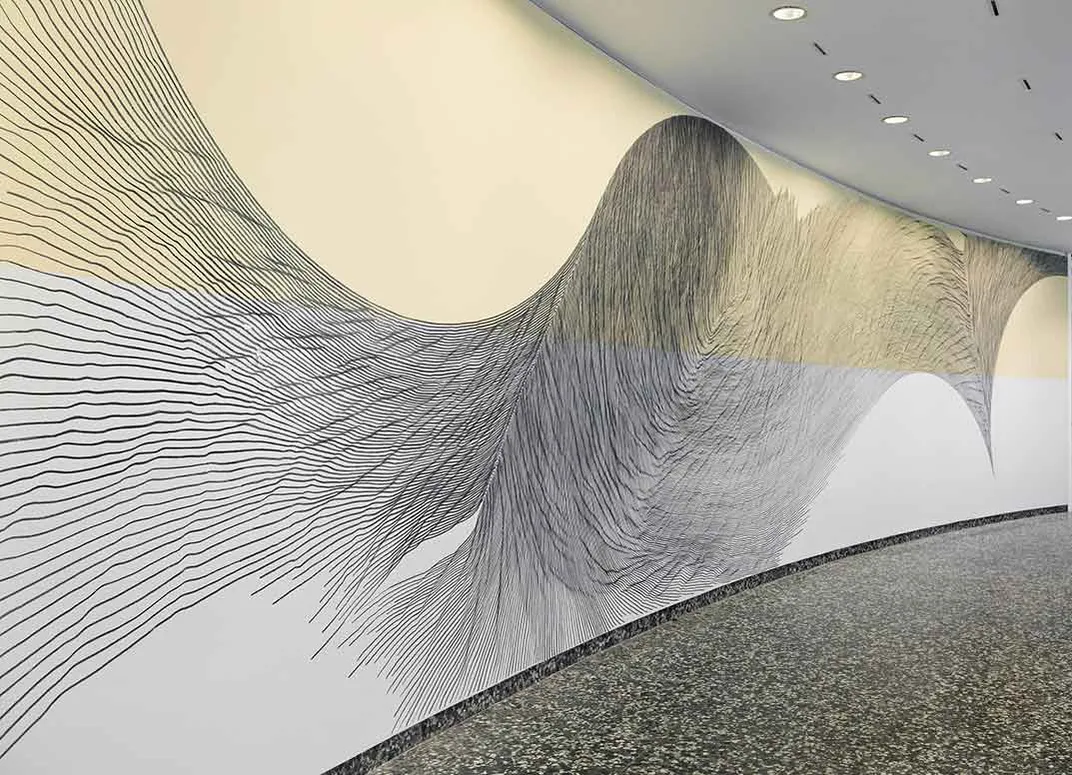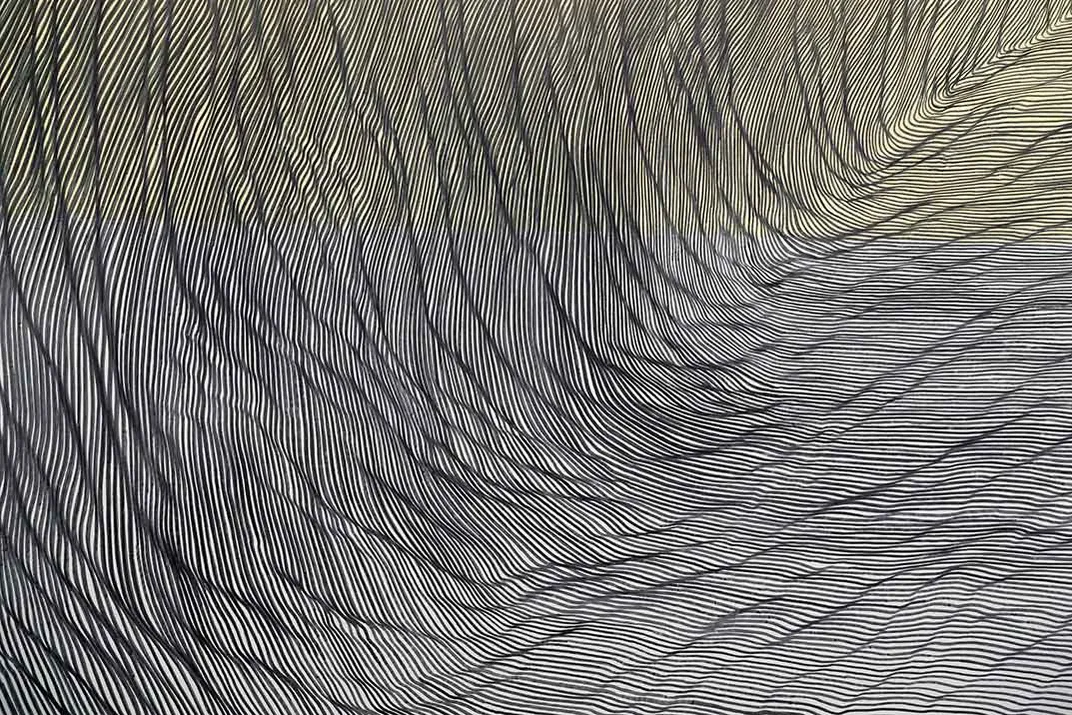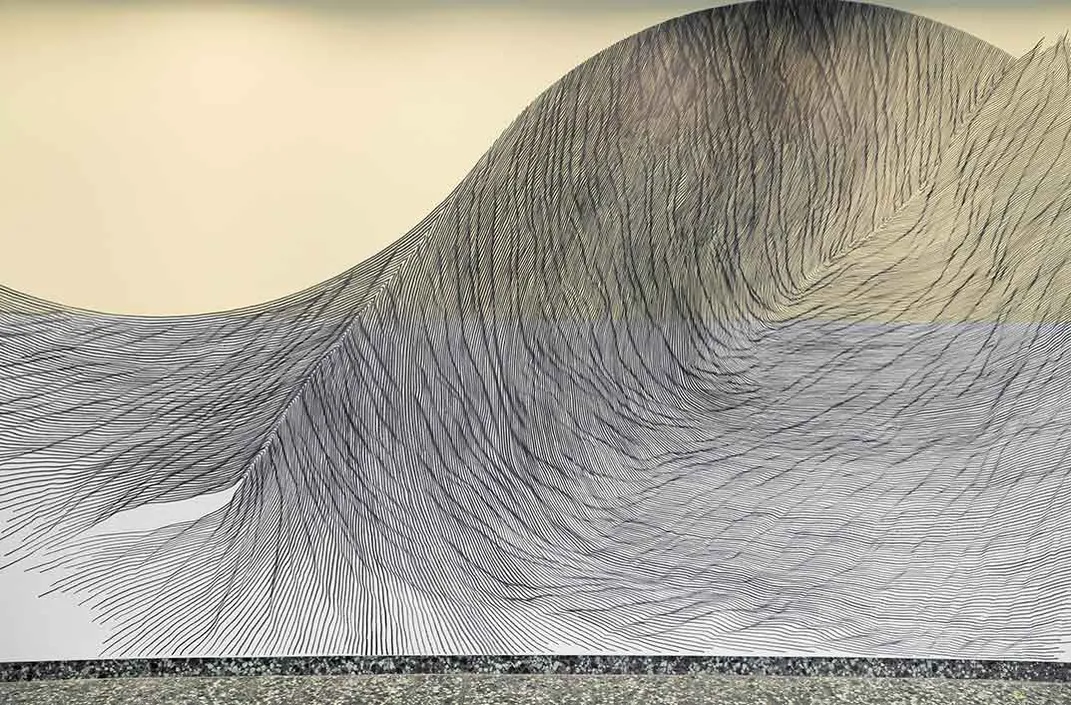The Mesmerizing Results When a Museum Asks an Artist to Draw All Over Its Walls
Linn Meyers took on the monumental task of creating a 400-foot-long artwork at the Hirshhorn
:focal(654x403:655x404)/https://tf-cmsv2-smithsonianmag-media.s3.amazonaws.com/filer/44/12/4412b796-1024-4667-a45f-918a61b60aed/linnmeyers5web.jpg)
When people say someone really “lives” her art, they may mean she takes her work very seriously. But for nearly three months, Linn Meyers’ life really did consist of her art – she hardly did anything else. She spent as many as 11 hours a day in the circular second-floor of the Smithsonian’s Hirshhorn Museum, drawing on the walls. Which might sound like child’s play, but most definitely isn’t.
Meyers used a combination of utmost precision and complete chance to create Our View From Here, a super-sized drawing that mesmerizes its viewers. Her work, which fills 400 linear feet of museum wall space, is on display through May 14, 2017, and is part of a recent effort to utilize new spaces within the Hirshhorn.
The museum was open for a good part of the time she was working on the piece, and fascinated visitors gawked as she applied her one chosen tool—a kind of thick marker favored by graffiti artists—to the walls, which were painted in two neutral tones. Although she sticks to a single color, the effect is anything but monotonous. The sinuous lines form waves and patterns that unfurl along with the museum walls, almost seeming to move. As the exhibition curator Stéphane Aquin says, “She just dances along with the building. Her art blends beautifully with the architecture. She reveals the movement that is inherent in the building.”
Meyers, a Washington, D.C.-based artist, creates both individual artworks in her studio and site-specific installations such as the one at the Hirshhorn (other installations have been on view at the Hammer Museum in Los Angeles and the Phillips Collection in Washington, D.C.). Meyers explains that when she creates a piece in a particular environment, she naturally has to pay attention to the building, to the space that will house her work: “One of the first questions I ask myself is, ‘How well can I approach the quirks of the architecture?’ ”
The main “quirk” at the donut-shaped Hirshhorn is that museum visitors, viewers of Meyers’ installation, will be following the circular inner walkway. “The space demanded that I create a piece that wrapped around the space, around that path that visitors take through the museum,” she explains.

“And then there are breaks throughout the space—doorways, entrances to galleries. In preexisting space or architecture, there’s always something that becomes a challenge. I don’t mean that in a negative way. A challenge can provoke some new approach to the way a piece would evolve. So in this case, it’s the way the circle of the gallery is divided into eight parts. And those openings aren’t always open. Sometimes the space is modified for an exhibition and some of the space is closed off. My piece will overlap with three different shows, and the space will change for each show. I had to think about that. That’s new. I’ve never had a dynamic gallery space before.”
Meyers’ first step was to create preparatory drawings, done at quarter-inch scale. Next, Hirshhorn staffers used CAD (Computer Assisted Design) software to trace a framework—the circles from Meyers' drawings—directly on the museum walls. Meyers then set to work with her Molotow brand graffiti pen, letting her hand go where it would. This is where chance and coincidence come in.
“All of the movement you see in those drawings is just a result of the process,” she explains. “It just evolves, the lines are not planned out. But the compositions are planned. That’s a play between the intended and the unintended. The geometry is mapped out beforehand in my preparatory work. When I would start a section, I would trace a circle. That’s the plan, the intended. Following that point, each line responds to the line before it—a sort of entropy, beyond my control. So: both intended and not-intended. A nice metaphor for life!”

Meyers’ color of choice for this project was a blue-gray called Payne’s gray. Because the artist diluted the color to different degrees, she was able to achieve different densities of color throughout the work.
As viewers walk around the rotunda, they can see that the line of the marker at times is so faint it’s just a whisper, while at other times it thickens into a blot, and still elsewhere, there is a mottled effect. In certain parts of the installation, there is a great deal of wall space that has been left undrawn-on, yet other sections are packed with crowded-together undulating lines.
Meyers realized that the first sections she did were the result of all the energy she had stored up while thinking about and planning the project: “The first couple of walls that I did are different than the last couple of walls. At first I was raring to go: all those months of preparation and anticipation. The mark is more aggressive. I kind of attacked the walls!” But by the end, when she allowed more of the walls to stand empty, she notices “a kind of lightness.”

Because of the circular dimensions of the rotunda, viewers aren’t able to see the entire piece all at once. It just isn’t possible. And that affects how they perceive the work. It was the same for Meyers. “I had this vision of what the whole thing would look like, but it’s not like in the studio where my eye can pass back and forth over a piece. In the studio, I make discrete works of art and you can stand in front of them. With this, you just physically can’t. I could see the section I’d finished, for example, but then not the section I was working on. You can’t view even a quarter of it at once, standing in one place.”
Such a mammoth undertaking required mammoth concentration. Meyers, who usually goes to her studio daily and works on multiple pieces at once, did neither.
“It was the longest time I’ve been away from my studio,” she says. “I did nothing else. It was good. That frantic way we exist in time—from social media to getting up and getting groceries to being on the phone—it’s just the way we live. But with this, to focus on one thing—it was such a wonderful thing to see progress every day. For hours, not really lifting my head.” As she worked in the museum in her hyper-concentrated state, museum staffers or curator Stéphane Aquin would approach her, try talk to her, and she wouldn’t even notice them. “I would just be so focused. I had to put my blinders on. That’s something we just don’t get to do.”
Perhaps because Meyer’s photograph is on display at the museum’s front desk or perhaps because of the quiet authority she exudes when walking through the finished installation, viewers sense that she’s the artist. They want to talk, compliment her, ask her questions, even pose for phone photos. Meyers grasps to explain her new mini-celebrity. “There’s an element of mystery to what goes on in the studio, where the work comes from. Not that I can distill all those elements for people, but they can see how simple it is: Just me drawing one line, and then drawing another line.”
"Linn Meyers: Our View From Here" is on view at the Hirshhorn Museum and Sculpture Garden through May 14, 2017 in Washington, D.C. Linn Meyers will give a talk about her work as part of the Hirshhorn's Meet the Artist series on Wednesday, May 25, at 6:30 in the museum's auditorium. It is free and open to the public.
UPDATE 5/25/2016: A previous version of this story indicated that it was the artist who worked with a CAD program. She did not. Museum staffers used this process. We regret the error.
/https://tf-cmsv2-smithsonianmag-media.s3.amazonaws.com/accounts/headshot/Smiling-Anne.jpg)
/https://tf-cmsv2-smithsonianmag-media.s3.amazonaws.com/accounts/headshot/Smiling-Anne.jpg)